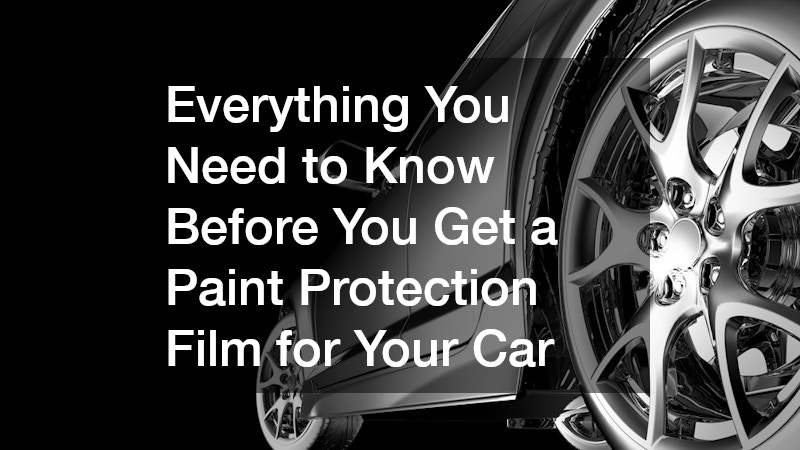Paint protection film, often abbreviated as PPF, is a thin layer of material applied to the exterior surfaces of a car to protect the paint from damage. This film is typically made from a thermoplastic urethane material, which is known for its durability and flexibility. Originally developed for military purposes, PPF is now widely used in the automotive industry to preserve the appearance of vehicles.
Its primary function is to act as a shield against various environmental threats such as stone chips, scratches, and UV rays. By acting as a protective barrier, PPF maintains the car’s aesthetic and resale value over time.
One of the key features of the paint protection film is its self-healing properties. This means that minor scratches and scuffs on the film can disappear over time due to the heat from the sun or the engine. The self-healing nature of PPF is a significant advantage over traditional waxes and sealants, which do not offer long-lasting protection. Furthermore, paint protection films are transparent, so they do not alter the appearance of the vehicle. This clear transparency ensures that the car looks as good as new, showcasing its original paint color and finish.
Installation of paint protection film requires professional expertise to ensure a seamless application. Skilled technicians are trained to apply the film without any visible cuts or edges, matching the contours of the car perfectly. The installation process typically starts with a thorough cleaning of the car’s surface to remove any contaminants that could affect adhesion. Once applied, the film should be free from air bubbles and imperfections. The installation process might take several hours to complete, depending on the size and complexity of the vehicle.
Benefits of Using Paint Protection Film
The primary benefit of installing a paint protection film is the preservation of your vehicle’s paintwork. With PPF, your car is less vulnerable to damage from road debris, bird droppings, and harsh weather conditions. This notably extends the lifespan of your car’s exterior, meaning less frequent trips to the body shop for touch-ups or repairs. Additionally, having a well-maintained vehicle increases its resale value, which is essential for owners intending to sell their cars in the future. Potential buyers will appreciate a car that appears well-kept, giving them the confidence that the vehicle has been cared for.
Another advantage of paint protection film is its contribution to the aesthetic appeal of your car. The film can enhance the gloss and shine of the vehicle, providing an attractive appearance that turns heads on the road. For those who invest in high-end or luxury cars, maintaining an immaculate look is of utmost importance. PPF provides peace of mind as it ensures that the car remains visually stunning without the added stress of constantly monitoring for damage. Moreover, some PPF options come with hydrophobic properties, which repel water and reduce stains, making maintenance easier.
In addition, the level of customization offered by paint protection films allows car owners to decide which parts of their vehicle require protection. Whether it’s the full body, front, or specific areas like the hood and mirrors, PPF installations can be tailored according to individual preferences. This customization makes it possible to prioritize areas most exposed to damage while remaining cost-effective. Furthermore, high-quality PPF can protect against some of the most stubborn environmental aggressors, such as acid rain and oxidation, keeping the vehicle pristine over time.
Considerations Before Installing Paint Protection Film
Before deciding to apply paint protection film, it is essential to consider the cost implications. Quality PPF and professional installation can be a substantial investment. However, when compared to the potential cost of body repairs and paint correction due to damage, it often proves to be a wise financial decision. Evaluating your driving environment is also crucial—those frequently driving in areas with rough terrain or urban environments might find more value in the film’s protection. Weighing these factors can help you determine the real-world benefits of PPF for your vehicle.
Another consideration is the maintenance involved with paint protection films. Although they require less upkeep than unprotected paint, some care is needed to ensure longevity. Routine cleaning is recommended, avoiding harsh chemicals that could degrade the film. Gentle washing and waxing specific to PPF-installed vehicles help maintain their effectiveness and appearance. Regular maintenance upholds the film’s protective qualities and extends its lifespan, ensuring your investment is worthwhile.
Lastly, it’s important to know that not all paint protection films are created equal. The market offers a wide range of PPFs with varying levels of thickness, clarity, and self-healing capabilities. Researching and selecting a reputable brand known for quality and durability will guarantee better results. Consulting with automotive professionals can provide insights into the best options available for your specific vehicle and requirements. By taking these considerations into account, car owners can make an informed decision regarding the installation of paint protection film.




